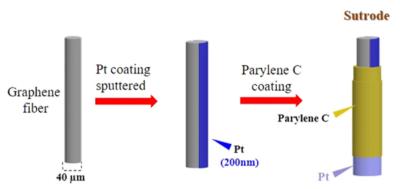An international team that included researchers from the ARC Centre of Excellence for Electromaterials Science (ACES) and the University of Houston has helped progress electroceutical research for treatment of diseases including rheumatoid arthritis, colitis and sepsis.
 Coating steps of extruded Pt-rGO electrodes. Image from article
Coating steps of extruded Pt-rGO electrodes. Image from article
The team released their latest paper, that builds on previous studies where the team reported on the 'Sutrode' - a graphene based electrode created using the fabrication technique known as fiber wet spinning.
This work has widespread implications for regulating the function of the spleen, particularly the efficient regulation of the immune response for electroceutical treatment of range of diseases, said Professor Wallace. We have highlighted the ongoing need to develop systems with increased fidelity and spatial resolution. This will not only bring practical applications to the forefront but will enable the unattainable exploration of the human neural system.
The work captured in the new paper also stresses the ability to interrogate simultaneously the four individual neural inputs into the spleen.
Professor Mario Romero-Ortega, a professor of Bioengineering and Biomedical Sciences at the University of Houston, said: The flexibility and superb sensitivity of the Sutrode is allowing us to expand our understanding of how the nervous system controls main body organs, a critical step towards developing advanced therapies in Bioelectronic Medicines. Our collaborative work uncovered that the spleen is controlled by different terminal nerves, and that the Sutrode can be used to control them, increasing the precision in which the function of this organ can be modulated.